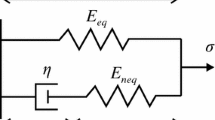Abstract
For ten models of the isothermal behavior of materials, the solutions of boundary‐value problems are studied for five types of the experimentally reproducible uniform stress–strain state with unchanged directions of the principal axes. It is found that, for three models, the governing equations are similar to the relations of Hooke's law and valid within the same range of the ratio between the shear and bulk moduli. In these models, the specific strain energy can be represented as a sum of the energies due to changes in volume and shape. The ranges where the other three known models exhibit incorrect behavior are determined.
Similar content being viewed by others
REFERENCES
C. Trusdell, A First Course of Rational Continuum Mechanics, Johns Hopkins Univ., Baltimore-Maryland (1972).
R. Hill, “ Determining inequalities for simple materials, ” Mekhanika (collected scientific papers) [Russian translation], No. 4 (1969), pp. 94–118.
A. I. Lur'e, Theory of Elasticity [in Russian], Nauka, Moscow (1970).
K. F. Chernykh, “ Determining inequalities for elastic bodies, ” in: Mechanics of Continuous Media and Related Problems of Analysis (to the 80th Anniversary of Acad. N. I. Muskhelishvili) [in Russian], Nauka, Moscow (1972), pp. 623–633.
E. L. Gurvich, “ Hadamard's condition in the nonlinear theory of elasticity, ” Izv. Akad. Nauk SSSR, Mekh. Tverd. Tela, No. 1, 45–51 (1979).
A. I. Lur'e, Nonlinear Theory of Elasticity [in Russian], Nauka, Moscow (1980).
K. F. Chernykh and Z. N. Litvinenkova, Theory of Large Elastic Strains [in Russian], Izd. Leningr. Univ., Leningrad (1988).
A. A. Adamov, “ Viscoelastic behavior of incompressible and slightly compressible materials at finite strains, ” Candidate's Dissertation in Phys.-Math. Sci., Perm' (1979).
M. Levinson and I. W. Burgess, “ A comparison of some simple constitutive relations for slightly compressible rubber-like materials, ” Int. J. Mech. Sci. 13, 563–572 (1971).
L. Treloar, The Physics of Rubber Elasticity, Oxford (1949).
G. M. Bartenev and T. N. Khazanovich, “ A law of highly elastic strains in cross-linked polymers, ” Vysokomolekulyar. Soed., 2, No. 1, 20–28 (1960).
S. T. J. Peng and R. F. Landel, “ Stored energy function and compressibility of compressible rubber-like materials under large strain, ” J. Appl. Phys., 46, No. 6, 2599–2604 (1975).
A. A. Rogovoi, “ Equation of state and functional for slightly compressible and incompressible materials under finite strain, ” in: Mechanics of Elastomers (collected scientific papers) [in Russian], Krasnodar, (1988), pp. 72–88.
V. A. Pal'mov, Vibrations of Elastoplastic Solids [in Russian], Nauka, Leningrad (1976).
R. W. Ogden, “ Large deformation of isotropic elasticity — on the correlation of theory and experiment for incompressible rubber-like solids, ” Rubber Chem. Technol., 46, No. 2, 398–416 (1973).
Author information
Authors and Affiliations
Rights and permissions
About this article
Cite this article
Adamov, A.A. Comparative analysis of the two‐constant generalizations of hooke's law for isotropic elastic materials at finite strains. Journal of Applied Mechanics and Technical Physics 42, 890–897 (2001). https://doi.org/10.1023/A:1017969215735
Issue Date:
DOI: https://doi.org/10.1023/A:1017969215735




